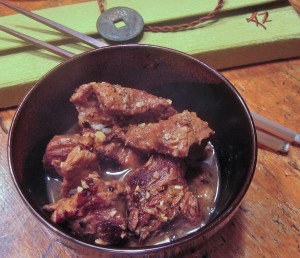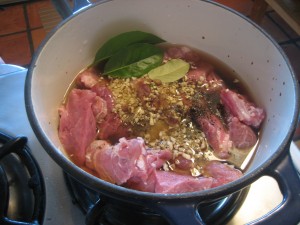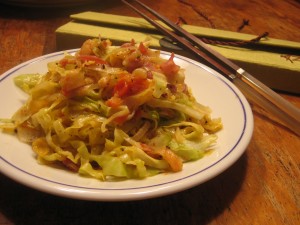Andrew and I always start our meals with a prayer. It’s not the traditional Catholic “for these gifts which we are about to receive” type of prayer. Somehow it has developed into a family prayer that encompasses all that we are grateful for – the needs of family and friends, current events, pets, jokes we’ve heard – you name it and this prayer time has hit it. Of course, “my turn” is a bit more orthodox and I try to get in some parenting with lines of “help us to be mindful of those who are less fortunate and to seek ways to alleviate their suffering” or “bless Andrew with a clear mind to help him remember to turn in his homework.” But Andrew’s prayers are utterly unorthodox, completely sincere, and always enlightening. Tonight was no exception.
“Dear God, thank you for all our blessings. Thank you for the food, our house, our pets, family friends, teachers, uncles, aunts, and everybody else. Thank you for adobo and thank you for putting it into some Filipino’s mind to invent adobo. Amen. “
If you have ever eaten Filipino adobo, you may already have a similar prayer of your own. If you are a newbie to it, you will soon be at the altar of this great dish.
Adobo is pork shoulder marinated in vinegar, garlic, and soy sauce; slow cooked, and served over rice. Deceptively simple and satisfyingly intriguing, it’s the pot roast and potatoes of the Philippines. This is a great midwinter dish and just right for a cozy night at home during a storm.
I have often wondered why Filipino food, especially adobo, has not reached the masses in America like Japanese or Chinese cuisine has. Of course, that was until years after eating my own adobo I tried it in a Filipino restaurant.
A Filipino friend brought me to his favorite authentic dive. I could hardly wait to try a “real” adobo. For an appetizer, we ordered lumpia that came out on a plate piled high with at least 25 of these deep friend, pork filled, Filipino spring rolls. It was a good thing that I had eaten myself nearly sick on lumpia. It turns out that the real version of adobo is a bit different from mine. My homemade version was a fairly lean, meaty affair, but this was a plate of giant chunks of fat with small tidbits of meat clinging on for dear life. Definitely an acquired taste.
Don’t let this scare you off though and do try this one at home. It will become a family favorite and on a cold winter night sometime in the future you, too, will be repeating Andrew’s prayer.
Here’s my version of adobo. I have also included a recipe for Guisadong Repollo (braised cabbage) for a perfect side dish. Just add some rice and your done!
Provecho!
½ cup cider vinegar
2 tablespoons soy sauce
1 tsp salt
4 to 5 cloves garlic, minced
3 bay leaves
½ to 1 tsp fresh ground black pepper
1 tablespoon sugar
½ cup water
1 ½ to 2 lbs pork shoulder cut into 2-inch pieces
2 or 3 tablespoons of oil for frying
Place all the ingredients in a non-reactive saucepan and let marinate for ½ hour to an hour. (I like my enameled Dutch oven.)
Bring to a boil and them turn down the heat and let simmer for about an hour or until the meat is tender. Remove the meat and reserve the liquid.
Heat the oil in a skillet large enough to hold the meat and brown the meat on medium high heat. Pour about a half cup of liquid in the pan with the meat to deglaze the pan and cook until almost dry. Pour the remaning liquid into the pan with the meat and let it cook for a few minutes more.
Note: You can use more or less garlic, more or less vinegar, fry up sliced onions before you brown the meat. Play around with this until you get the right mix for you and your family. Andrew and I like it strong! It also makes good friend rice if you have any leftovers.
Braised Cabbage (Guisadong Repollo)
Based on a recipe in Filipino Cuisine by Gerry Gelle
A good slug of oil for frying
3 cloves garlic, minced
1 onion, sliced
1 tomato, chopped
¼ lb ham, procuitto, or left over pork, cut into thin strips or diced
½ cup shrimp, chopped (or little bay shrimp)
1 cup chicken broth
1 lb cabbage, sliced thinly
1 tsp salt
½ teaspoon black pepper
Heat the oil in a skillet and sauté the garlic until it is light brown. Add the onions and sauté until transparent. Add the tomatoes and sauté until they are soft.
Add the pork and shrimp and sauté for a minute or two. Stir in the broth and bring to a boil.
Add the cabbage, salt and pepper. Cook until the cabbage is just tender, about 5 minutes or longer if you like your cabbage softer.
This is really delicious and worth trying.



{ 6 comments }
Awesome Don—not sure where I came from or if we are really related with our extremely different taste in food, but the story is great! 🙂
hi, how are you uncle don and andrew?
You are absolutely and utterly amazing! I can barely fry an egg when I get home.
Hugs
Joyce
Don,
Your story about Adobo is great! When I was a young girl in Santa Cruz a dear friend of ours would always make chicken adobo when we came for dinner. She has now confessed to me that that is one of the few dishes in her culinary repertoire! And, no, she’s not Filipina!
Anyway, in my first job after college there were lots of Filipinos in my company, I had since learned to make that delicious chicken adobo from my childhood. I told one of the guys at work that I knew how to make a really delicious adobo. He asked me to make it and bring some to work. So I did. My recipe was fairly similar to yours, just made with chicken instead of pork. When my friend tasted it he said “This is good, but it doesn’t taste like adobo!” Now I know why. He couldn’t (or wouldn’t) explain to me how my adobo differed from the traditional Filipino adobo but I think I was missing all those large chunks of fat you described from your meal at a Filipino restaurant.
Thanks for the dinner idea, now I know what we’re eating tomorrow night!
Made this last night — outstanding! Everything, the adobo and the cabbage, was so tasty and even better today. Easy, fast, and delicious – my kind of cooking.
Outstanding blog post, I look forward to reading more.